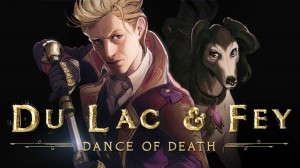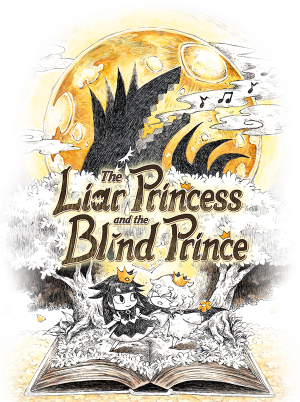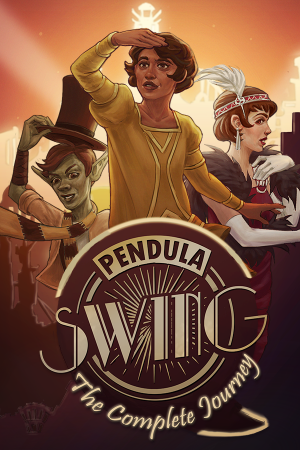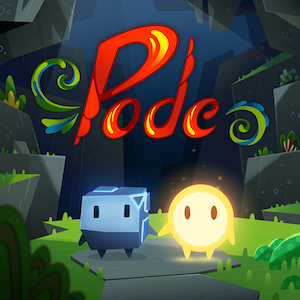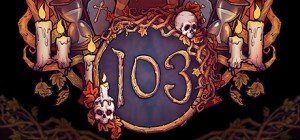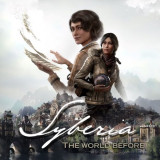Review for Dance of Death: Du Lac & Fey
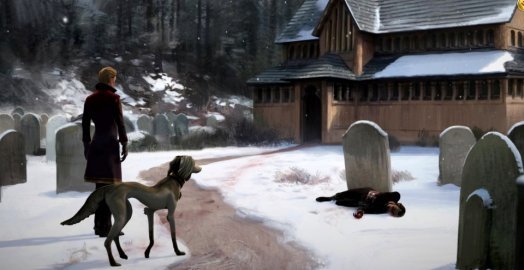
I’m a big fan of the heroic tales of antiquity like Robin Hood and the tales of Camelot. When I discovered in the prologue of Salix Games’ Dance of Death: Du Lac & Fey that the title characters are in fact Sir Lancelot Du Lac and Morgana le Fay – immortals now living in Victorian England – I was intrigued. When I learned they were a pair of demon hunters, I was excited. But when it turned out they’d be tracking down Jack the Ripper in 1888, I was apprehensive, as solving the Ripper murders has proven notoriously hard to dramatize in interactive form. Still, I was game and hoped for the best. Sadly, for a variety of reasons unrelated to the legend-blending lore, the game never lives up to the potential initially displayed.
Du Lac is something of a good natured if mildly bumbling dandy. Fey is a clever, perspicacious witch who was once cursed by Merlin to forever be a dog, albeit a slender and beautiful one with floppy ears and different coloured eyes. Very early on it’s established that there’s a mystical bond between Du Lac and Fey, and the exploration of their connection and history together forms a strong subplot within the overall narrative. Other characters are also revealed to have magical abilities as the game progresses, and collectively they are known as the Arcane.
It soon becomes apparent that the protagonists have been together for too long. (Several centuries!) They snipe at and tease one another, and generally get on each other’s nerves. But bicker as they may, they do so in a way that only deeply bonded friends ever could, always there to support one another when the chips are down. This complex relationship is conveyed in no small part due to the excellent vocal performances for this pair. It’s a nuanced and charming partnership of the kind that is seldom seen in interactive storytelling, and I found it easily the most enjoyable, satisfying aspect of Dance of Death.
The playable prologue in snowy rural Norway has Du Lac and Fey summoned by nearby villagers to investigate a grisly murder that turns out to be the result of supernatural forces. In this case it’s a demon that must be destroyed, which entails a brief action sequence with a slider moving back and forth along a marked scale. Clicking the mouse when the slider is in the correct range will strike the demon successfully. Several such blows win the battle and it’s very easy to accomplish, but for those who don’t enjoy such action elements, allowing the demon to attack Du Lac several times sees Fey come to the rescue automatically. A couple more sequences like this appear throughout the game and can be similarly bypassed.
Upon the demon’s defeat, Du Lac and Fey are shown a series of images that hint at the whereabouts of Merlin. It seems he too is still alive and continuing to work his magic to keep Fey trapped in her canine form. The visions lead the pair to London, where the game proper starts and they soon get swept up in the hunt for Jack the Ripper.
Despite its obviously fictional premise, Dance of Death is well researched and based on the actual events of the Ripper case. While this is admirable it also worried me, because while the police worked hard to stop the gruesome killings, one of the key problems with this mystery is that that there wasn’t any real evidence trail to follow. Put another way, in terms of gameplay, it’s very hard to create something out of nothing. This is an issue that plagued Sherlock Holmes vs. Jack the Ripper as well, with the great detective being given a number of asinine tasks not worthy of his mettle as there wasn’t anything else for him to do.
In an attempt to remedy this, a few fantasy elements come into play here, as Du Lac and Fey believe a mystical motivation drives the infamous killer. Sadly, even with this magical bent the usual problem afflicts Dance of Death. By the time our heroes reach London, several deaths have already occurred. The protagonists do get to inspect a number of crime scenes, but I never really got the feeling that I was doing anything meaningful or getting closer to the Ripper through any actions of my own.
If the game had remained focused on Du Lac and Fey’s search for the macabre murderer – or for Merlin, who is largely thrust into the background for long stretches – it might have been able to stay afloat based solely on the charm of the two leads. However, a third playable character is introduced, one Mary Jane Kelly. I’m not sure if she actually has more play time than the title characters or if it just feels that way, but I found her inclusion to be problematic.
Plucked from the real cast of characters involved in the Ripper case, Mary is the clichéd prostitute with a heart of gold. She looks out for the children of Whitechapel and teaches other women how to read. Unfortunately, we learn very little about Mary’s background or who she is. It’s not so much that she’s a bad character; it’s just that she significantly pales in comparison to the immortal Sir Lancelot and Morgana of Arthurian legend. It doesn’t help that during her gameplay segments she’s given trivial make-work projects to do, such as walking from scene to scene to distribute flyers to pedestrians. Every time the game switched to Mary, I really wanted to be back with Du Lac and Fey instead.
Ultimately the three characters come to work together. Mary gets paired with Fey on a couple of occasions, and the cunning hound does help elevate these sections a little bit. Even so, there are still parts that feel like filler. After Mary herself receives a vision of the next Ripper victim, she and Fey start to look for the woman only to end up…at the local brothel getting drunk while playing a 19th century version of Truth or Dare with the other working girls there. It’s an odd, boringly extended interlude, during which even Fey questions the reason for being there.
Overall, the story is patchy at best. There are moments that are really quite enjoyable, but the rest of the time is rather dull. Not poorly written by any means, just not particularly engaging. Even the ending, which I reached after seven hours of play, left me cold as it’s rushed through surprisingly quickly while trying to tie up all the loose ends. In the dénouement, even though Du Lac and Fey see the Ripper case through to the finish, they feel like they really haven’t accomplished anything towards their own eternal pursuit. Having guided them to that point, I shared that same feeling, as the ending is more intent on setting up the prospect of a sequel than providing much closure to this one.
Of course, there’s more to Dance of Death than just a story, although not much. The game generally plays like a typical 2.5D point-and-click adventure. 3D characters are rendered over top of hand-painted backgrounds. A button in the top-right corner allows for toggling between whichever playable characters are currently available, though there's rarely any need to do so. A few standard genre elements are conspicuous by their absence, however, such as an inventory or any real puzzles. The closest the game comes are a couple of potion crafting tasks involving clicking various chemical ingredients to add them together. General insights about the types of ingredients appear on-screen, but these are too vague to be any help. I found it easier to simply choose at random until the potion turned the right colour, indicating it was created correctly.
In the absence of anything requiring either logic or lateral thinking to figure out, your purpose is largely to move the characters from one hotspot in the environment to another. Relevant objects only become active – denoted by an on-screen icon appearing – when your character gets close enough to interact with them. This is even true of exits, meaning you have to physically walk across the screen, sometime waiting for it to scroll with you, and only then are able to leave. Oddly, the designers made the choice to only ever allow one objective at a time, so the “mystery” isn’t about figuring anything out (even the crime scenes), just walking around to find the next scene or hotspot to advance the plot.
At times there are close-ups that must be searched, such as a deceased body (at least one of which is slightly gory) or a desk full of papers. These sections also felt rather empty and trivial to me, as hotspot markers are immediately displayed on all the important elements and the “search” consists of nothing more than clicking on each one in turn, which usually causes the clicked point to vanish.
The heavily streamlined formula grows tiresome very quickly. From the time they arrive in London to the closing moments of the game, Du Lac and Fey – and Mary once she becomes available – are generally confined to the same dozen scenes. Five of these are street exteriors where the point of view is pulled so far back that it’s quite a slog to cross them, even when double-clicking to (barely) increase the protagonist’s movement speed. The other seven locations include shop interiors, the local church, and the pub/inn where Du Lac and Fey are staying.
Occasionally you do visit other locations after the Ripper has committed a crime, but these are always short-lived before returning to the same twelve scenes. While the backdrops are well-painted, they share a rather drab palette and depict quite generic locations. Few are particularly noteworthy or memorable, though you do get the chance to revisit them at different times of day and night, and they take on a spookier appearance in the dark with fog rolling in. The only place in London that stood out visually to me was the chemist’s shop. The proprietor is a magical tree creature – who has a glamour over him so that non-Arcane people perceive him as a bespectacled old man – and his shop is vivid and overgrown with vibrant plant life. Strangely, many scenes are populated with a combination of 2D, almost cartoonish background characters and 3D real-time rendered ones, which helps create the sense of a larger community but can be stylistically jarring.
Beyond walking from one place to another, the primary interaction comes from conversing with the next key character. These dialogs typically switch back and forth between close-up views of those involved. At various points during the conversation, two or three responses are provided. While the options allow you to select a slightly different attitude or approach, I didn’t really get the feeling it mattered what I picked. The game seemed structured so as to always keep moving forward along a linear path regardless of whether I was friendly or haughty, sympathetic or sarcastic. Much of the play time consists of these exchanges, but they don’t seem to matter in the grand scheme of things, which would have been fine if there had been other things to do instead.
Although your encounters with the Whitechapel locals don’t offer much in the way of interactivity, they are still one of the highlights of the game due to their aesthetic quality. Clearly a lot of effort went into the character models, their expressions and animations. Du Lac’s drunken walk is so wonderfully done that it is a joy to watch, and Fey’s movements are always smooth and graceful yet still convincingly canine. It should perhaps be noted that there are a couple brief scenes of nudity, though sexual relations are more implied than seen.
Voices too are well done. I don’t have a great ear for accents, but the ones here sounded genuinely European to me. Fey’s cultured tones and range of emotions are particularly impressive. Mary has a Welsh accent that’s very pleasant-sounding as well, but periodically there are line readings that come across as not being a natural part of the conversation. Whether odd inflections that turn statements into questions or vice versa, or Mary suddenly and unexpectedly raising her voice for a line or two when the person she’s talking to is right next to her, it causes a break in immersion and makes the troublesome Mary sections just a little bit more difficult to get through. Quite a bit of profanity comes out of people’s mouths, including Mary, but on balance it’s used in moderation and actually feels justified under the circumstances.
Musically Dance of Death feels era-appropriate. Much of the score is played on winds or piano, with strings coming in every now and then. It’s pleasing to listen to and never overshadows the ambient audio, complementing the on-screen action by growing quiet and mysterious when investigating crime scenes and more bombastic during the action beats. Effects are pretty solid as well: the fluttering flip of tarot cards, the strikes of Du Lac’s sword, and the smile-inducing click-click of Fey’s nails as she pads across the floor are all well done. Even details like the murmuring of crowds along the streets of Whitechapel are given attention. It’s actually possible to stop and listen to some of the background chatter, at least until it noticeably starts repeating.
Regrettably, there are a number of technical issues that could have used the same degree of focus, as the game has quite a few niggles and a general lack of polish. Take the close-up conversations, for example. While the characters are nicely animated, I experienced visual glitches like the game flickering back to wider room shoots for a frame or two between camera cuts, having conversations play out entirely against blank walls, characters not facing one another when speaking, and missing props such as a champagne bottle that the people are clearly meant to be interacting with.
Even walking is a rather rough experience due to dodgy pathfinding. Care must be taken to always click on an obviously unobstructed spot on the ground to move, or else the current playable character might wander off in some random direction or simply not move at all until you click again a few pixels away. If another character gets in the way they are pushed along in front of you, sliding across the scene like snow before a plough.
The biggest rough spot that affected me was the save system, or lack thereof. This game continues the ill-advised modern trend of not allowing players to make their own save games. Instead there is only a single save slot that is updated automatically as you progress. Dance of Death illustrates why this approach is such a bad one. Mere minutes away from completing the game, I had to exit out without realizing how close I was to the end. When I returned later and attempted to continue, the game did not properly resume, instead placing me in a scene with Du Lac and Fey standing around a bonfire (actually, Fey was standing in the fire). No amount of clicking could get either character to react, so after restarting a couple of times, I conceded that my save file was corrupted and wandered off to YouTube to see the closing moments of the story. Not the way I would have chosen to end my experience, obviously.
With its assortment of glitches and lack of meaningful gameplay, Dance of Death: Du Lac & Fey feels like it was rushed out the door before it was complete. However, even if most of its technical issues are resolved – and to their credit, the developers have been working hard on updates since launch – the case of Jack the Ripper is a mystery that doesn’t lend itself to being investigated, let alone solved. And with what feels like the majority of the play time spent with Mary and her rather banal tasks, it’s often rather tedious. For all that, I sincerely hope Salix will produce a sequel focused on the aspects that do work, while learning from those that don’t. The notion of an urban fantasy set in Victorian times is an intriguing one, and the chemistry and interplay between Du Lac and Fey is as good as any pair of game characters I’ve ever witnessed. Is the game worth playing for these bits alone? That’s a tough call. For me the charm of the two Arthurian principles just edges out the ennui of the rest of this excessively-linear experience. I would love to see a better, more refined adventure for Sir Lancelot and Morgana in the future, because I think it could well be something quite magical.


